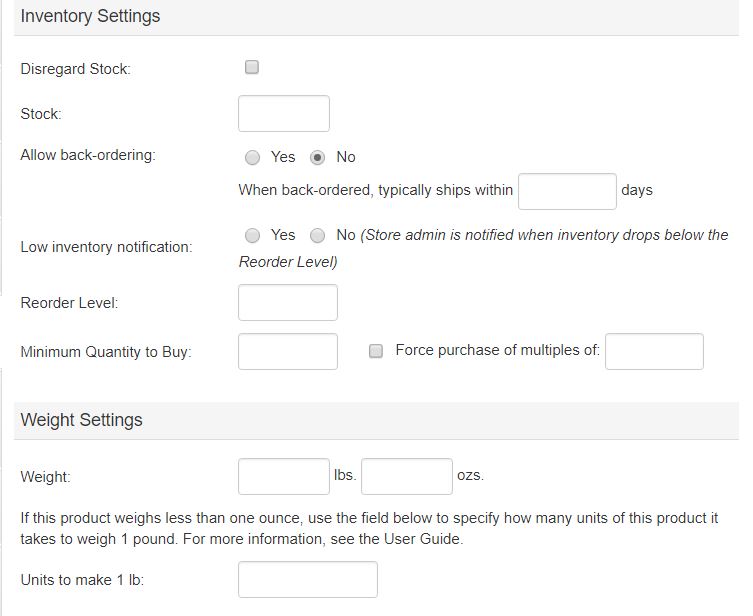Add New Product - Inventory, Weight, & Shipping
Inventory Settings
ProductCart contains a number of inventory-related features. Use the Store Settings page to set general inventory settings, such as whether or not inventory levels should be shown on the product details page, whether out of stock merchandise can be purchased or not, and whether an out of stock message should be displayed.When inventory is tracked (products that are out of stock are not available for sale), there are three inventory statuses that a product can be in:
- In Stock - the product is available for purchase. The inventory level may or may not be shown on the product details page, depending on how the corresponding store setting has been set.
- Out of Stock - the product is not available for purchase because it is not currently in stock.
- Back-Ordered - he product is available for purchase even if it's not currently in stock because this is a product that is regularly restocked. The storefront shows how frequently the product is typically re-stocked
For example, if you setup a product with 18 units in stock, allowing back-ordering, indicating that it is typically restocked every 7 days, and setting a low inventory notification at 10 units, then your ProductCart-powered e-commerce store would behave as follows:
- The product would be available for purchase as there are 18 units in stock.
- The administrator would be notified via e-mail when inventory drops under 10 units.
- When the product becomes out of stock, customers that visit the store will still be able to purchase it, but they will shown a message that indicates that the product Typically Ships in 5 Days.
The three inventory statuses listed above become IRRELEVANT when:
- The entire store has been set to allow the purchase of out of stock items. This setting is located on the Store Settings > Store & Display Settings > Order & Customer Related tab.
- The product itself has been set to disregard stock (e.g. a service, for which there is no inventory).
Product-Specific Inventory Settings
 />Let’s review each of the settings that are located in this area of the Add/Edit product page:
/>Let’s review each of the settings that are located in this area of the Add/Edit product page:
- Disregard Stock - Check this option if the item can be purchased even when out of stock or if it's not an inventory item (e.g. downloadable software). All other inventory-related settings are ignored when Disregard Stock is checked.
- Stock - Enter the current stock level for this product. This is an optional field, which can help you manage your inventory. If a product is out of stock and you have selected the Show Out of Stock option under Store Settings > Miscellaneous, then the product details page on your store will display an Out of stock message unless the product allows back-ordering. If back-ordering is allowed, the message is replaced with Typically Ships in .. Days.
- Minimum Quantity to Buy - Enter a number if you want to set a minimum purchase quantity for the product. The quantity field on the product details page, which normally contains a “1”, will automatically be set to the selected quantity. Validation is performed throughout the storefront to ensure that the customer can only purchase the product in an amount that equals or is higher than the number of units you specify here.
- Force Purchase of Multiples of Minimums - This setting tells ProductCart that the product can only be purchased in set quantities, and that those quantities can only be a multiple of the minimum purchase amount. For example, if you were to sell “business cards”, you would probably not sell customers 4 business cards, but rather require that they purchase at least a few hundreds. In addition, you will not want a customer to order 302 business cards, but rather a more easily manageable multiple of, let's say, 50 (i.e. 300, 350, 400, etc.). In this scenario you would want to enable this option and enter 50 in the Minimum Quantity to Buy field.
- Allow Back-ordering - When you allow back-ordering, you are telling your customers that even if a product is out of stock, you expect the product to be back in stock within N days, and you will ship their orders then. It’s up to your customers to decide whether they still wish to order the item or not.
- Typically ships within [ ] days - This is the number of days that it typically takes for the product to be back in stock. This number is shown to customers in the storefront. It should be an average of the time it takes for that product to be restocked. The actual message shown in the storefront can be edited by changing the corresponding text string in the file includes/languages.asp. Customers are used to seeing this type of message as it is used by many, leading e-commerce Web sites.
- Low Inventory Notification - You can configure ProductCart so that the system notifies you via e-mail when inventory drops below the Reorder Level. NOTE re: Apparel Sub Products: the Low Inventory Notification E-mail is the setting for Apparel Parent Product only, and the notification e-mail is only sent only when the inventory level of all sub-products is lower than the Reorder Level.
Weight and Shipping
 Supplier and Drop-Shipping
Supplier and Drop-Shipping
- Supplier - You can associate a product with a supplier. Select from a list of available Suppliers. You can add/edit suppliers using the Manage Suppliers feature. This feature is currently useful only for reporting purposes. In the future, we plan to expand it so that suppliers can be given the ability to manage their own products through a special administration area (to upload new product images and descriptions, for example).
- Drop-Shipping - You can specify whether the product is drop-shipped and choose the drop-shipper. The drop-shipper menu is inactive until you specify that the product is drop-shipped.
Weight
- Weight - Enter the product's weight, in pounds and ounces (kilograms and grams if you store is setup to use Kg). The weight can be used for dynamically calculating shipping charges. For information about configuring shipping options see Shipping Options. If you set the weight to zero, then customers will not be prompted to select a shipping option during the check out process (except for custom shipping options that are not based on the order weight). Technically speaking, the weight is saved to the database in one field, as ounces or grams. If you are importing or exporting product data, you will only see one value associated with the product weight.
- Units to Make 1lb - If a product weighs less than one ounce or less than one gram, use this field to specify how many units of this product it takes to weigh 1 pound or 1 kilogram. This feature allows you to properly calculate the order weight when a single unit of the product weighs less that the lowest weight unit accepted by ProductCart, which is 1 ounce or 1 gram.
Oversized Settings
Setting a product as Oversized makes ProductCart replace the default package size with the package dimensions entered here. Please see the Shipping Options section for more information about entering default package dimensions for your shipments. For now, note that “length” should always be the longest dimension..In some cases (e.g. UPS), oversized items incur extra shipping charges. However, if you set a product as Oversized, but the actual package weight and size do not fall into the oversized category, the shipping provider will return the correct rate.
Another consequence of enabling the Oversized option is that when you set an item as oversized, it will automatically be handled as a separate package when calculating shipping charges. ProductCart allows you to handle multiple package shipments to more accurately calculate shipping rates on your orders.
Shipping Surcharge
You can specify that a shipping surcharge be added to the total shipping charges for an order.- First Unit Surcharge
When customers purchase the product, the shipping surcharge is added to the shipping charges shown in the storefront. - Additional Unit(s) Surcharge
When customers purchase more than 1 unit of the product, the shipping surcharge specified in this second field is used on all units beyond the first one.- If you only want a surcharge on the first unit, leave this second field set to 0.
- If you want the same surcharge on all units, enter the same value in both fields
- If you want a different surcharge on all units following the first one, enter that amount here. Remember that the amount is multiplied by the total number of units purchased (of this product), minus the first unit (for which the “First Unit Surcharge” is used).
NOTE:
- Amount is always added to the Shipping Charge (not shown as a separate line item)
- These two fields cannot be imported
- These two fields cannot be exported
- These two fields cannot be edited through Global Changes
